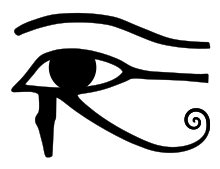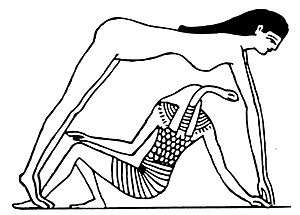Geb
Geb was the Egyptian god of the Earth and later a member of the Ennead of Heliopolis. He had a viper around his head and was thus also considered the father of snakes. It was believed in ancient Egypt that Geb's laughter created earthquakes[1] and that he allowed crops to grow.
| Geb | |||||
|---|---|---|---|---|---|
God of the earth, vegetation, fertility, earthquakes, snakes | |||||
 | |||||
| Name in hieroglyphs | |||||
| Symbol | barley, goose, bull, viper | ||||
| Personal information | |||||
| Parents | Shu and Tefnut | ||||
| Siblings | Nut | ||||
| Consort | Nut, Tefnut | ||||
| Offspring | Osiris, Isis, Set, Nephthys, and Heru-ur. | ||||
| Greek equivalent | Cronus | ||||
Name
The name was pronounced as such from the Greek period onward and was originally read as Seb[2] or some guess as Keb. The original Egyptian was perhaps "Seb"/"Keb". It was spelled with either initial -g- (all periods), or with -k-point (gj). The latter initial root consonant occurs once in the Middle Kingdom Coffin Texts, more often in 21st Dynasty mythological papyri as well as in a text from the Ptolemaic tomb of Petosiris at Tuna El-Gebel or was written with initial hard -k-, as e.g. in a 30th Dynasty papyrus text in the Brooklyn Museum dealing with descriptions of and remedies against snakes.
Role and development
| Part of a series on |
| Ancient Egyptian religion |
|---|
 |
|
Beliefs |
|
Practices
|
|
Deities (list) |
|
Locations |
|
Symbols and objects
|
|
Related religions
|
|
|
The oldest representation in a fragmentary relief of the god, was as an anthropomorphic bearded being accompanied by his name, and dating from king Djoser's reign, 3rd Dynasty, and was found in Heliopolis. In later times he could also be depicted as a ram, a bull or a crocodile (the latter in a vignette of the Book of the Dead of the lady Heryweben in the Egyptian Museum, Cairo).
Geb was frequently feared as father of snakes (one of the names for snake was s3-t3 – "son of the earth"). In a Coffin Texts spell Geb was described as father of the snake Nehebkau. In mythology, Geb also often occurs as a primeval divine king of Egypt from whom his son Osiris and his grandson Horus inherited the land after many contendings with the disruptive god Set, brother and killer of Osiris. Geb could also be regarded as personified fertile earth and barren desert, the latter containing the dead or setting them free from their tombs, metaphorically described as "Geb opening his jaws", or imprisoning those there not worthy to go to the fertile North-Eastern heavenly Field of Reeds. In the latter case, one of his otherworldly attributes was an ominous jackal-headed stave (called wsr.t) rising from the ground onto which enemies could be bound.
In the Heliopolitan Ennead (a group of nine gods created in the beginning by the one god Atum or Ra), Geb is the husband of Nut, the sky or visible daytime and nightly firmament, the son of the earlier primordial elements Tefnut (moisture) and Shu ('emptiness'), and the father to the four lesser gods of the system – Osiris, Seth, Isis and Nephthys. In this context, Geb was believed to have originally been engaged with Nut and had to be separated from her by Shu, god of the air.[3] Consequently, in mythological depictions, Geb was shown as a man reclining, sometimes with his phallus still pointed towards Nut. Geb and Nut together formed the permanent boundary between the primeval waters and the newly created world. [4]
As time progressed, the deity became more associated with the habitable land of Egypt and also as one of its early rulers. As a chthonic deity[5] he (like Min) became naturally associated with the underworld, fresh waters and with vegetation – barley being said to grow upon his ribs – and was depicted with plants and other green patches on his body.[6]
His association with vegetation, healing[6] and sometimes with the underworld and royalty brought Geb the occasional interpretation that he was the husband of Renenutet, a minor goddess of the harvest and also mythological caretaker (the meaning of her name is "nursing snake") of the young king in the shape of a cobra, who herself could also be regarded as the mother of Nehebkau, a primeval snake god associated with the underworld. He is also equated by classical authors as the Greek Titan Cronus.
Ptah and Ra, creator deities, usually begin the list of divine ancestors. There is speculation between Shu and Geb and who was the first god-king of Egypt. The story of how Shu, Geb, and Nut were separated in order to create the cosmos is now being interpreted in more human terms; exposing the hostility and sexual jealousy. Between the father-son jealousy and Shu rebelling against the divine order, Geb challenges Shu's leadership. Geb takes Shu's wife, Tefnut, as his chief queen, separating Shu from his sister-wife. Just as Shu had previously done to him. In the book of the Heavenly Cow, it is implied that Geb is the heir of the departing sun god. After Geb passed on the throne to Osiris, his son, he then took on a role of a judge in the Divine Tribunal of the gods.[7]
Goose

Some Egyptologists (specifically Jan Bergman, Terence Duquesne or Richard H. Wilkinson) have stated that Geb was associated with a mythological divine creator goose who had laid a world egg from which the sun and/or the world had sprung. This theory is assumed to be incorrect and to be a result of confusing the divine name "Geb" with that of a Whitefronted Goose (Anser albifrons), also called originally gb(b): "lame one, stumbler".[8]
This bird-sign is used only as a phonogram in order to spell the name of the god (H.te Velde, in: Lexikon der Aegyptologie II, lemma: Geb). An alternative ancient name for this goose species was trp meaning similarly 'walk like a drunk', 'stumbler'. The Whitefronted Goose is never found as a cultic symbol or holy bird of Geb. The mythological creator 'goose' referred to above, was called Ngg wr "Great Honker" and always depicted as a Nilegoose/Foxgoose (Alopochen aegyptiacus) who ornithologically belongs to a separate genus and whose Egyptian name was smn, Coptic smon. A coloured vignet irrefutably depicts a Nile Goose with an opened beak (Ngg wr!) in a context of solar creation on a mythological papyrus dating from the 21st Dynasty.[9]
Similar images of this divine bird are to be found on temple walls (Karnak, Deir el-Bahari), showing a scene of the king standing on a papyrus raft and ritually plucking papyrus for the Theban god Amun-Re-Kamutef. The latter Theban creator god could be embodied in a Nilegoose, but never in a Whitefronted Goose. In Underworld Books a diacritic goose-sign (most probably denoting then an Anser albifrons) was sometimes depicted on top of the head of a standing anonymous male anthropomorphic deity, pointing to Geb's identity. Geb himself was never depicted as a Nile Goose, as later was Amun, called on some New Kingdom stelae explicitly: 'Amun, the beautiful smn-goose (Nile Goose).[9]
The only clear pictorial confusion between the hieroglyphs of a Whitefronted Goose (in the normal hieroglyphic spelling of the name Geb, often followed by the additional -b-sign) and a Nile Goose in the spelling of the name Geb occurs in the rock cut tomb of the provincial governor Sarenput II (12th Dynasty, Middle Kingdom) on the Qubba el-Hawa desert-ridge (opposite Aswan), namely on the left (southern) wall near the open doorway, in the first line of the brightly painted funerary offering formula. This confusion is to be compared with the frequent hacking out by Ekhnaton's agents of the sign of the Pintail Duck (meaning 'son') in the royal title 'Son of Re', especially in Theban temples, where they confused the duck sign with that of a Nilegoose regarded as a form of the then forbidden god Amon.[9]
Notes
- "Geb". Retrieved 6 October 2014.
- Wallis Budge, E. A. (1904). The Gods of the Egyptians: Studies in Egyptian Mythology. Kessinger publishing. ISBN 978-0766129863. Retrieved 6 October 2014.
- Meskell, Lynn Archaeologies of social life: age, class et cetera in ancient Egypt Wiley Blackwell (20 Oct 1999) ISBN 978-0-631-21299-7 p.103
- Van Dijk, Jacobus. "Myth and Mythmaking in Ancient Egypt" (PDF). Jacobusvandijk. Retrieved 26 May 2017.
- Dunand, Francoise (2004). Gods and Men in Egypt 3000 BCE to 395 CE. Armand Colin. p. 345. ISBN 9780801488535.
- Wilkinson, Richard H. (2003). The Complete Gods and Goddesses of Ancient Egypt. Thames and Hudson. p. 105–106. ISBN 9780500051207.
- Pinch, Geraldine (2002). Handbook of Egyptian Mythology. Santa Barbara: ABC-CLIO. pp. 76, 77, 78. ISBN 9781576072424.
- C. Wolterman, "On the Names of Birds and Hieroglyphic Sign-List G 22, G 35 and H 3" in: "Jaarbericht van het Vooraziatisch-Egyptisch genootschap Ex Oriente Lux" no. 32 (1991–1992)(Leiden, 1993), p. 122, note 8
- text: Drs. Carles Wolterman, Amstelveen, Holland